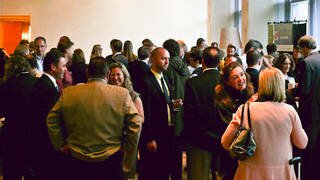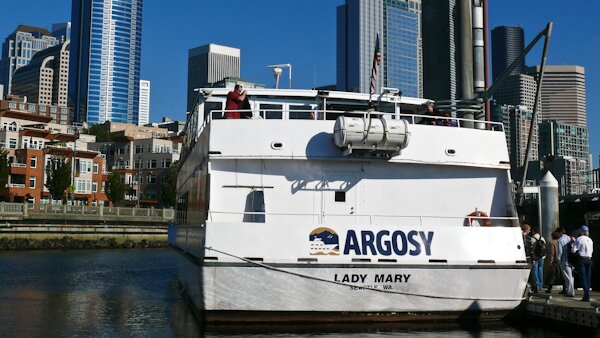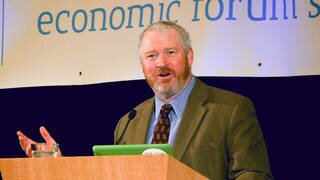In yesterday's post about health care reform's staying power, I quoted T. R. Reid saying that our canny Senator Maria Cantwell "got it," when it came to reform that works. Minutes after that post went up, Cantwell's press office sent a release out titled "Cantwell Calls for State Review of Steep Health Care Premium Rate Hikes."
At issue is insurer Regence's decision to stop offering child-only policies and jack 2011 premiums for Washington policy holders by as much as 37 percent. Cantwell says that Regence is attributing the premium increase to health care reform, and in a letter to State Insurance Commissioner Mike "Bulldog" Kreidler, she wrote:
Blaming these premium increases on the Affordable Care Act is clearly contrary to analysis and estimates about the law’s impact on premiums and only perpetuates misunderstanding and misinformation about the law. If Regence chooses to continue anti-consumer policies, I ask that you explore all consequences, including exclusion from the state exchange.
Responds Kreidler: "I'm appalled. We’ve made regulatory concessions to limit Regence’s exposure. Their overreaction will seriously harm Washington families. [...] So far, no other health carrier in Washington state has signaled its intent to leave this market. I hope we can expect better from them." (Here are the firms still selling child-only policies in the state.) [UPDATE 10/15/10: "Kreidler orders Regence BlueShield to cover children"]...
 Almost nothing about T. R. Reid's Seattle Arts & Lectures talk on health care last night was what I expected. His book The Healing of America is in paperback now ($10.88 from Amazon), and remains the gold standard for the non-wonk citizen curious how the rest of the world pulls off universal health coverage at about half the cost of the U.S.
Almost nothing about T. R. Reid's Seattle Arts & Lectures talk on health care last night was what I expected. His book The Healing of America is in paperback now ($10.88 from Amazon), and remains the gold standard for the non-wonk citizen curious how the rest of the world pulls off universal health coverage at about half the cost of the U.S.
The unexpected? Without exception, everyone who learned I was going to a health care talk used--in some variation--the word "snooze." Actually, Reid, a veteran Washington Post correspondent, had the audience laughing throughout much of the night ("You owe me big-time"), and always engaged ("You get me?" is Reid's guy-at-the-bar underlining of key points).
And though brash statements don't usually faze Seattle Arts & Lectures patrons--Jonathan Franzen was just in town--sustained murmuring rose from the crowd when Reid closed by saying he thinks there's a good chance Obamacare will fail: either because of legal challenges or political intransigence. Then, universal health care might be put back on the table, possibly by a moderate, fiscally conservative Republican.
("As I look down the road I know America is good at heart..." goes a line from John Adams' Nixon in China.)
The thesis of Reid's book, which surveys health care systems around the world, is that universal health care is a fundamentally a moral and ethical decision. Moral because countries decide whether, through inaction, they're willing to let someone die. Ethical, because universal health care speaks to fairness--everyone participates.
Reid disparaged the Obama administration's health care reform, saying they did a "lousy job" of selling the plan to Americans. It was on the one hand a landmark reform and on the other we were told, "If you're happy with your current health care, nothing will change." This proposition underscored, for Reid, the selfish basis of the appeal. Universal health care will never gain support because it doesn't affect you personally--it gains support because it's an expression of deeply felt values....
 Photo: Staton Dubois, via our partner site Capitol Hill Seattle
Photo: Staton Dubois, via our partner site Capitol Hill Seattle
Last week's arrival of a bike box at 12th Avenue and Pine has prompted new grumblings from people who apparently can't count. (The "trapezoid" on Madison is bringing stormy denunciations as well.)
People who complain about cyclists--and correct me if I'm wrong--seem to do so because they're in a hurry. Here's a thought experiment: If we take away Seattle's three percent of bicycling commuters and add the same number of cars to the road, can you imagine what happens?
Reliably, the Seattle Times story on the event has over 100 comments, largely from people who feel that road safety should be based solely on anecdotal stories about how all cyclists run red lights or who argue that cyclists, being a strange breed of being who pay no sales, property, or gas taxes (Did you know no cyclists own cars? Not one! It's ideological) should have to pay for license and registration.
There are real concerns you can have with Seattle's growing bike infrastructure, but these aren't admissible. Some drivers flaunt traffic laws every second of every day, making other drivers crazy, but few have suggested not paying for lane striping would improve the situation. And for the record, there is no cyclist lobby pushing for red-light-running privileges; it's dangerous for everyone and the more tickets handed out for it, the better.
As for taxes...the math doesn't work the way the easily outraged seem to think. As Seattle Bike Blog notes, only the cyclist pays close to their way in taxes--car drivers pay about one-tenth the actual cost of driving in taxes and fees. If we want to start charging on a usage basis, let's start with the people who are really enjoying a socialized ride....
The Seattle Times says these are shaping up to be the most intense La Niña conditions since 1955, which is ironic because the Eisenhower administration still seems more progressive than the Times editorial board. ZING! (No, we have fun.)
Typically, La Niña simply brings the wetness until about January, when we see more snow than usual. So you have some time to stock up on snow shovels, hot chocolate, and sleds. But there's never been a better time to adopt-a-drain and make sure your street doesn't flood.
Back in June, the FDIC warned Shoreline Bank to find some more money, and they couldn't, so Shoreline Bank was seized and sold on Friday. It had deposits of $100 million, which doesn't seem bad for a three-branch bank. It was the tenth Washington bank to fail this year, and the 129th nationally. In other big money news, the office towers at The Bravern in Bellevue sold for $410 million, and the Seattle Bubble knows where you can pick up a 6,500-home planned development cheap....
Readers of The SunBreak will have noted we have been relatively quiet on the subject of Mayor McGinn's proposed budget for next year. (Vote for your cranky cost-saving measures here.) I simply have not been able to get my arms around the beast, outside of general outlines.
 One delineation to make is that this budget crisis is a revenue problem, not a wasteful city spending problem. In 2008, the general fund budget was $925 million, last year it was $905 million, and this iteration is $888 million. Meanwhile, the city's four main revenue streams--taxes on utilities, sales, businesses, and property--growing at six to eight percent annually in the boom years, fell off a cliff in 2009, entering negative territory.
One delineation to make is that this budget crisis is a revenue problem, not a wasteful city spending problem. In 2008, the general fund budget was $925 million, last year it was $905 million, and this iteration is $888 million. Meanwhile, the city's four main revenue streams--taxes on utilities, sales, businesses, and property--growing at six to eight percent annually in the boom years, fell off a cliff in 2009, entering negative territory.
Another bright, shining line is the difference between the general fund and the total city budget, which last totals over $3.8 billion dollars. That is, almost 80 percent of what the city spends annually lies outside the general operating budget. Instead over 200 city staff are being fired. That's why Ken Schramm, no mayoral ally, says suck it up when it comes to parking rate increases. There ain't no easy way out.
Still, Mayor McGinn says he welcomes fierce argument over his budget choices, and Blogging Georgetown has responded with a critique of cutting library hours and services at a time when they are needed more than ever. "The old man" has graciously allowed us to republish his broadside:
The mayoral candidate that allegedly lavished such love on South Park during the election is proposing cutting librarians from the South Park branch of the Seattle Public libraries. According to the [Seattle] Times, the budget that he submitted to the city council included cuts from SPL, including "Delridge, Fremont, International District/Chinatown, Madrona-Sally Goldmark, Montlake, New Holly, South Park and Wallingford — [which would] would lose their librarians. The buildings would be open 35 hours a week for collections, computer access and holds-pickup."...
Yesterday I took a two-hour of the Duwamish waterway, courtesy of the Port of Seattle, who each year offer a "Port 101" series to keep Seattleites informed on what being a port city means in the 21st century. (I can also recommend the Ship Canal tour.) We embarked from the Bell Harbor Marina, at Pier 66.
Argosy Cruises provided the boat. Joining us were representatives of the Environmental Protection Agency, Duwamish River Cleanup Coalition, Environmental Coalition of South Seattle, and Muckleshoot Tribe. Sitting next to me was a woman working in one of Boeing's environmental departments. Why all the enviro-brass? Because besides being scenic, the Lower Duwamish Waterway is a Superfund site....
 "In its first quarter in the market, Apple's iPad shipments exceeded the combined volume of nearly 40 eBook reader suppliers with a 3.3 to 2.4M unit advantage," says IMS Research's Quarterly eBook and iPad Shipment and Forecast Service.
"In its first quarter in the market, Apple's iPad shipments exceeded the combined volume of nearly 40 eBook reader suppliers with a 3.3 to 2.4M unit advantage," says IMS Research's Quarterly eBook and iPad Shipment and Forecast Service.
Their press release goes on to mention that eBook readers still made a good showing, with volume up 28 percent quarter over quarter; Amazon gained share in the market, along with Barnes & Noble, but still refuses to release sales figures on its Kindle.
You get a sense of the market differential, though, when IMS Research mentions they expect Apple to ship over 15 million iPads in 2010, and all eBook readers to total 13 million. Next year they predict greater separation, with over twice the iPads sold as eBook readers.
Expect to see touchscreens and color in eBooks sometime in 2011, as manufacturers try to counter iPad popularity.
 City Councilmember Nick Licata
City Councilmember Nick Licata
I can already see Nick Licata's Christmas card to Mayor McGinn: "Thanks for making me look middle-of-the-road." The City Council's Licata has long been--years before President Obama's election--Seattle's "socialist" in city government, often ending up on the wrong end of the teeter-totter from everyone else on the Council.
With McGinn assuming the loose lefty cannon mantle, Licata has been free to act as the voice of reason. Today, he's brokered a compromise to quell the contretemps arising from the funding of MOHAI's move to the Lake Union Armory. (The details are spelled out in his Urban Politics newsletter, which will be up shortly.)
With statesmanlike restraint, Licata chose to focus on the more proximate needs of the two parties at odds: Mayor McGinn needs to find cash to balance the budget, and MOHAI needs all the help it can get to survive its move. What Licata rather cunningly realized is that the two cash crunches don't coincide in time. His compromise means the city will still pay MOHAI the agreed upon $7 million, but not during the next budget year.
Restructuring the release of the $40 million that MOHAI will receive from the State can achieve these two objectives. The City will retain $8.5 million during 2011 and 2012 and then pass that amount onto MOHAI after we receive our share of the land proceeds in 2013 or later. The result is that we have real cash to spend on one-time needs, like summer youth employment, library collections, and food banks that we otherwise would not have....
(more)
 In his introductory remarks at last week's Sustainable Industries Economic Forum, Mayor McGinn seemed to forget the word of the day was optimism, asking the audience had they all read Jared Diamond's Collapse.
In his introductory remarks at last week's Sustainable Industries Economic Forum, Mayor McGinn seemed to forget the word of the day was optimism, asking the audience had they all read Jared Diamond's Collapse.
McGinn referenced the "Who cut down the last tree?" question that is always asked about Easter Island--summing up hindsight's incredulity at completely using up a renewable resource.
As to how that happens, "we're getting a clue right now," he added, complaining that we set environmental and sustainability goals, and then ignore them when it comes to large transportation projects.
To be fair, McGinn was also preparing for a city budget address that called for laying off over 200 city employees, so some gloominess was perhaps inevitable. (In a later Q&A, David Williams, CEO of ShoreBank Pacific, noted that the economy was "still deteriorating" and that he expected it to take five to seven years for it to pull out of its slump.)
 Cameron Sinclair, Architecture for Humanity
Cameron Sinclair, Architecture for Humanity
Then Cameron Sinclair--co-founder and "eternal optimist" at Architecture for Humanity--gave a keynote was supposed to be the antidote to any wet-blanketry, but if so, it came in the form of a tough-love caplet. Sinclair, now in his late 30s, is a "socially conscious architect" who won a TED prize in 2006 for his work, and used the prize money to fund what he calls "open source architecture," where people can share their ideas about camel-back clinics, among other things....
Mayor McGinn is giving a public budget address today at noon at the Rainier Beach Community Center. It won't be particularly cheery; the city has a $67 million general fund deficit for 2011, and that's after substantial cuts have already been made throughout the recession (which, we remind you, is over).
"Considerable input from residents is needed to develop a budget that best reflects the needs of our city," says the City Council, so they are inviting you to vote online or attend one of these three public hearings in North, South or Central Seattle:
- Wednesday, September 29
Northgate Community Center Gym
10510 5th Ave NE, 98125
5:30 p.m. Public Hearing (5 p.m. sign-in) - Wednesday, October 13
The Brockey Center at South Seattle Community College
6000 16th Avenue SW, 98106
5:30 p.m. Public Hearing (5 p.m. sign-in) - Tuesday, October 26
Seattle City Hall Council Chambers, 2nd floor
600 Fourth Avenue, 98104
5:30 p.m. Public Hearing (5 p.m. sign-in)
The weather gods, after soaking us with monsoons the past two weeks, smiled up on the grand opening of Lake Union Park. The temperature climbed above 70 degrees, and skies blued. Paddle boarders paddled, model boats sailed, kids ran through water features, everyone else lined up at the Molly Moon ice cream truck. The twelve acres have still to grow into themselves in some areas, and MOHAI has not yet installed itself in the Armory, but it's already an inviting place to spend the afternoon. Finally Lake Union's maritime history, much of it tied up to the wharf, is just a waterfront promenade away. It just seems a little odd--how did we leave this out?--that there's not a café anywhere.
 City Council President Richard Conlin is confident he did the right thing. Also, here is a picture of a Babydoll sheep.
City Council President Richard Conlin is confident he did the right thing. Also, here is a picture of a Babydoll sheep.
It's probably no surprise to learn, as Publicola reports, that a supermajority of the City Council thinks having a mayor is "more of a guideline." (Possibly related: It's Turn In Your Old Drugs Day.)
While you're over there, read the Council's Tim Burgess on why he was all, "Yeah, send Bishop Conlin!" which crystallizes the kind of project-capture thinking that places going forward with the tunnel above respecting the city's charter. Quote of the week goes to Mike O'Brien, who notes that, "Only in Seattle would we have a coup over who signs an environmental-impact statement."
Late Friday, regulators seized Arlington's North County Bank, and sold it to Whidbey Island Bank; bad development and construction loans ended up costing the FDIC (and you and me and everyone we know) almost $73 million dollars, about 25 percent of the bank's total value.
In the latest on the multiple fatal shootings in West Seattle, the 60-year-old grandmother is said to have had a history of mental illness, and--more troublingly--she may have been taking medication erratically. Many people are not aware that the kinds of drugs used now to treat depression and schizophrenia can have horrendous side-effects if suddenly discontinued....
 Council President Richard Conlin
Council President Richard Conlin
Yesterday at 5:38 p.m. I got an email from the City Council announcing that "Seattle City Council President confirms next phase in Alaskan Way Viaduct environmental review,"and that Council President had signed the supplemental draft environmental impact statement (SDEIS) so the city could "remain as co-lead on the [...] project."
The problem with this "git-r-done" mentality is that it doesn't follow the established process and contravenes the city charter. The official signatory for the SDEIS would be Peter Hahn, the chief of Seattle's Department of Transportation. And Hahn reports to Mayor McGinn, who had told him not to sign yet--not the Council. The City Council has no authority in the matter, an upset Mayor McGinn told The Stranger last night.
The City Council's predictably defensive email goes on to explain that the deadline for signing was yesterday, and nothing was happening:
The Director of Seattle Department of Transportation (SDOT) had a scheduled appointment with the state to complete this task. This date has been known to all parties since early July. Yesterday, the Mayor requested more time to review the SDEIS.
It may sound like the deep-bore tunnel SDEIS has been sitting around since July, but as Publicola reports, the city was given just a few days to review it and hand back:...
When Sound Transit CEO Joni Earl presented her Proposed 2011 Budget of nearly $1.1 billion to the Sound Transit Board on Thursday afternoon, she had a sobering message: Faced with a 25-percent revenue shortfall since 2008 (amounting to $3.9 billion), Sound Transit will not be able to meet all the objectives in the planned 15-year time frame for Sound Transit 2 approved by voters in 2008.
The good news is that Sound Transit's project management toolbox no longer includes hiding under the bed and waiting for bad news to go away.
"No organization can confront an expected 25 percent reduction in revenues without asking--and answering--hard questions about priorities," Sound Transit Board Chair and Snohomish County Executive Aaron Reardon was quoted as saying in a Sound Transit release. "It is important that we address these issues now and continue to move forward with expanding the region's mass transit system as rapidly as we can."
Earl outlined a series of program realignments designed to keep Sound Transit moving forward, albeit in a trimmer, adaptable way. In a PowerPoint presentation given to the board, she broke down the projects in the ST2 15-year plan into five categories: Design & Construct, Keep Moving, Retain Only Limited Funding, Suspend, and Delete....
Our correspondent Mindy Jones is a Seattleite living in Paris for two years. When she's not busy trying to figure out what the French are saying, she's busy trying to figure out what to say to the French. She posts frequently at An American Mom in Paris. Previously in Reluctant Parisienne posts.
We were stunned and slightly embarrassed. Considering my familiarity with Paris, Alex’s first language being French, and our hilarious overconfidence in our abilities, we assumed we would handle our move to France with enviable grace and flexibility. We knew it would not be effortless, of course, but we thought it would be effort-not-bad, and perhaps even effort-fun.
False. No matter who you are and where you go, an international move is like being a newborn baby without a mommy. Your surroundings are new and confusing, no one makes any sense and you cry easily and often, without shame. Thankfully the need for diapers doesn’t creep back in, which was surprising in our case considering public toilets in Paris are as elusive as berets on native French speakers.
After the first painful month, the haze lifted just a tiny bit. I learned to accept the sinking heart feeling when I tried to speak French and got only forehead creases and blank faces in response. My jaw stopped dropping when I saw how much I owed for groceries. I made a new friend when I accidentally told our building maintenance man I loved him. “Je t’aime” is one of the phrases that comes easily to me in French and thus slips out at inopportune times, especially when I’m flustered.
There were bigger things that were more intense. Lucien got scary sick and I didn’t know who to call for help. (I’ve since tattooed the French emergency numbers on my phone-dialing finger.)
Alex’s job turned out to be more demanding than he’d anticipated and he worked longer hours than in Seattle. When we asked a French friend about the much ballyhooed French 35-hour work week, she laughed and told us that only applies to jobs that “do not matter.” Alex did not take comfort in the fact that he mattered, and apparently mattered a lot.
We moved into our permanent apartment, an apartment for which we’d fought desperately a few months earlier on our pre-move apartment scouting trip.
Apartment hunting in Paris is a competitive, tedious and humbling process. Even with a relocation company advocate by our side and Alex’s employer paying the rent, our dossier was rejected a couple dozen times before we were tossed a bone. But what a bone. She’s small but what she lacks in size, she makes up in personality. ...
 An ExactTarget study makes the claim that your Twitter followers are more valuable than Facebook fans. Summarizes eMarketer: "Daily Twitter users who followed a brand were more than twice as likely as daily Facebook users who 'liked' a brand to say they were more likely to purchase from the brand after becoming a social media follower." (NB: What people say they are likely to do is highly dubious data.)
An ExactTarget study makes the claim that your Twitter followers are more valuable than Facebook fans. Summarizes eMarketer: "Daily Twitter users who followed a brand were more than twice as likely as daily Facebook users who 'liked' a brand to say they were more likely to purchase from the brand after becoming a social media follower." (NB: What people say they are likely to do is highly dubious data.)
I'd argue that for a media site, the value runs the other way. Our Twitter engagement is with colleagues and fans who enjoy a more active, thumbnail-news alert presence. We sometimes have back-and-forths on Twitter, but mostly we're pinging people with news-bites. If it's highly clickable, sure, we'll see retweets, but if it's a quiet, unassuming little story, then not so much. On Twitter, that is.
 The people on Facebook I think are also fans but not of our "performance" necessarily--they are fans of sharing. It's not a study, but I do have data for this. We've not been fanatic about our social media presence in any way. We have 585 Twitter followers, and we have 187 Facebook fans. Guess which group provided 35 percent of our referral traffic the last 30 days?
The people on Facebook I think are also fans but not of our "performance" necessarily--they are fans of sharing. It's not a study, but I do have data for this. We've not been fanatic about our social media presence in any way. We have 585 Twitter followers, and we have 187 Facebook fans. Guess which group provided 35 percent of our referral traffic the last 30 days?
Twitter brought in just seven percent of our referrals, despite The SunBreak appearing on 60 lists. (Admittedly, we did have a very popular story about Facebook members during that time. But still, the previous 30 days yields a 26 percent Facebook to 9 percent Twitter split.)
...
Every time I visit Victoria BC, it's a different city. A different, yet still completely crazy city. A constantly evolving kind of crazy, so that I am never able to get my bearings, to feel comfortable or oriented, despite a mostly shared culture and language. I've felt more at home in Tokyo than I do in Victoria.
My last visit to Victoria was among the most depressing holidays of my life. We saw a show at a club that shall remain nameless to protect the pathetic, a Stygian hole featuring the musical stylings of the clinically depressed bartender, who sang about his part-time job working in a retirement home in a manner that was neither funny, nor plangent. It was the most horrifying exhibition of talentless narcissism I have ever had the misfortune to witness. I cringed on his behalf, even as I longed for him to slit his wrists on stage, in order to put us all out of his misery.
This visit was better, for the most part. I had a poutine of duck confit over truffle fries at The Office (the fries were tasty enough, but there was too much duck in the confit and the curds were more like half-melted cubes of bland mozzarella), and Hermann's Jazz Club, self-billed as "suitable for ladies without escorts," is a terrific venue....
Seattle/Local Health Guide tipped me off to this Kaiser Health animated short attempting to explain health care reform without screaming and death panels. If you've you've been putting off reading the 1,000-plus pages of legislation, this makes a good way to pick up the essentials of how it'll work without the eyestrain.
It turns out I made good use of my time by leaving last week's waterfront design presentation just after James Corner had a go. Today the City of Seattle announced that James Corner Field Operations (unsic) would be lead designer for the central waterfront project.
JCFO is a New York firm, but on this project it has eleven collaborators, four of which are based in Seattle: Mithun, The Berger Parnership, Herrera Environmental Consultants, and Jason Toft, who is a person and not really a firm.
Coming up next, says the Department of Planning and Development:
The City will select the project manager and engineering team for the Central Waterfront project next week. Design work will begin in October 2010 with a conceptual design expected in 2012 and a final design to be delivered in 2015. Construction is scheduled from 2016 to 2018.
A few things impressed me about Corner, most notably his evident desire to create something people talk about--(review "high line" on Google Trends)--and enjoy, whether or not they could articulate that desire.
His references to his native Manchester's working class and Seattle's working waterfront felt like a requisite attempt to establish bona fides, as were put-downs about homogenization, but I was struck more by his off-the-cuff observations (one about how Seattle was "immersed in weather" suggested an early and important realization that this isn't San Diego). ...
I know, the recession is over. But here's the first line of a Seattlepi.com article this morning: "King County Executive Dow Constantine announced Tuesday morning that his proposed budget would eliminate all general fund support for human services." It would also cut ten percent of the sheriff's budget.
That's in response to the county's $60 million deficit. Seattle's projected deficit is now $67 million. The state of Washington, $520 million. Reports Bloomberg: "Washington has reduced spending by $5.1 billion in the past three years, Gregoire said last month. Yesterday, she said the state faces a deficit of almost $4.5 billion in the two-year budget cycle that begins in July." The cuts will come from social services, corrections, and community colleges.
KIRO quotes Arun Raha, the state's chief economist, saying, "In Washington, the job recovery this time around has been slower than in any of the previous four recessions. If you compound that with the fact that the hole we're in is the largest in living memory, you begin to comprehend the magnitude of the problem."
The irony, of course, is that the city, county, and state don't spend that much, proportionally, on social services to begin with. When Constantine zeroes out social services spending--sorry, battered women and anyone who has been raped--he's addressed about one-third of the problem.
But the state is pushing ahead with a plan for a larger replacement of SR 520's floating bridge--work is underway, despite there being $2 billion in funding missing from the $4.65 billion project. (How much larger? "The current SR 520 is 60 ft. wide through Foster Island in the Arboretum. The plan calls for an 133 ft. wide structure," wrote Mayor McGinn in a letter to a group protesting the new bridge's size.)...
Special to The SunBreak by Mark Taylor-Canfield
Recently I had an opportunity to interview Travis Bishop, a former U.S. soldier who was sentenced to a year in prison at Fort Lewis after being court marshaled for refusing to deploy to Afghanistan in 2009. Sgt. Bishop had already served in two military hot spots--the demilitarized zone between North and South Korea, and in Baghdad, Iraq, just outside of the so-called "Green Zone."
Bishop became disillusioned with his service in the army. After failing to deploy to Afghanistan, he applied for Conscientious Objector status, but the U.S. Army claimed that since he had already served in Iraq and South Korea, his CO application was invalid. Army CO regulations require the applicant to be opposed to all forms of war for religious, cultural, or intellectual reasons.
Bishop served a total of seven months in the brig at Fort Lewis where he says some guards treated him "like a terrorist." The U.S. Army demoted him from a sergeant to a private and he is now facing a dishonorable discharge from the military.
Amnesty International designated Travis Bishop as a "prisoner of conscience." The judge in his court marshal case received over 400 letters requesting amnesty in his behalf. As a result, Bishop was released almost four months early....
"Buyers know that now is the time to get the big home with a view at a price that is hundreds of thousands less than just a couple of years ago, and at an incredibly low interest rate," says West Seattle Redfin agent Dan Mullins. He wasn't talking about condo auctions specifically, but he captures the appeal succinctly.
 For real estate market watchers, the auction is also a useful barometer. Over the weekend, 32 condos in the luxury condominium tower Olive 8 hit the auction block, and the results support those dismal few prognosticators who suspected, back in the boom days, that the market was overvalued by some 30 percent.
For real estate market watchers, the auction is also a useful barometer. Over the weekend, 32 condos in the luxury condominium tower Olive 8 hit the auction block, and the results support those dismal few prognosticators who suspected, back in the boom days, that the market was overvalued by some 30 percent.
Keep in mind, while perusing the Olive 8 sales, that this is what a luxury downtown condo goes for. Wendy Leung at Seattle Condo Review gives you a great by-the-numbers breakdown (with more granularity than you'll find in the Seattle Times Olive 8 auction story):
The homes were sold for an average of 66% of the previous listing price, which is very close to the average of the last few auctions (Queen Anne High School, Lumen, Brix, Gallery, and 5th and Madison) since 2009 at 67%.
Leung goes on to separate out high and low bids by condo size, and to work out their price per square foot. While the average discount from list price was 34 percent, a larger two-bedroom went for only 54 percent of list. The units being sold ranged between the 18th and 26th floors in the 39-story tower--the more expensive units above, over 100 unsold, have "price tags from $500,000 to $6.9 million," says the Seattle Times, who also make room for a cheery broker's quote:...
My companion and I hit Courtenay, BC, around mid-day Thursday and Courtenay, much like the singer of similar name, hit back. I have to admit, I should have seen it coming.
On the ferry to Nanaimo, I got into the most cordial throw-down of all time with a lovely woman who was herself going to Courtenay. The woman asked to buy a cigarette from me. I offered her the cigarette free of charge. She insisted that she couldn't possibly. I protested that as I was not a licensed tobacco vendor, it would be illegal, as well as unethical, for me to accept her money...et cetera.
Eventually, my nameless new friend took the cigarette and kept her money, and I spent the next ten minutes hearing about her various offspring. Mixed in there somewhere was a brief mention of something called the Seniors Games. We parted on good terms, but I should have Googled "Seniors Games."
The BC Seniors Games are an annual competition in which members of the hip-replacement set come together to compete in events ranging from archery to Whist. (My ferry friend was competing in the Bridge tournament.) The games are held in a different location each year. This year, the silvered thousands descended on Courtenay for the weekend, vehicles circling downtown in a Miltonian search for free parking. Belligerent old men were knocking people over to get first into queue for restaurant tables (I have the bruises to prove it), and every hotel, motel, B&B, guesthouse, and RV park in the Comox/Campbell River Valley was reported to be booked solid.
So, of course, the B&B we'd booked (and confirmed twice) had been double-booked by the flaky reflexologist (is that redundant?) who owns the place, and the other couple had arrived first. Vera greeted us with a blank stare, followed quickly by horror, a rapid search for alternate accommodations, and the offer to pay for said accommodations. This time, I accepted an offer to pay without hesitation. I have no idea what our very nice room in a chain hotel ended up costing, nor do I particularly care. By the time we settled in, we were tired, cranky, stinky, hungry, and feeling very, very ugly-American, though trying hard not to show it....
 Artist's rendering of Chihuly exhibit at Seattle Center
Artist's rendering of Chihuly exhibit at Seattle Center
This is a wise decision, since their conclusion that visual arts are underrepresented on Seattle Center campus--ergo, the Chihuly exhibit wins--immediately raises questions about the Center's dogsled-racing, amateur-yodeling, and unicorn-riding gaps. I don't think anyone would argue that the works of Dale Chihuly are underrepresented in Seattle as a whole, and certainly not in places where people tend to go to see visual art, like, say, museums.
The wonderful thing about this bemusingly circular process is that these eight citizens armed with the truth are all members of the Center's Century 21 Committee. When we rely on their judgment that the Chihuly exhibit represents the best financial resource for the Center--which is a debatable top priority--let's keep in mind that these are the same people who drafted the Center's largely unfunded 20-year master plan to begin with. Here is a graph that illustrates their credibility.
Other things that happened in Seattle this week include the Storm returning victorious, the Columbia Center's mother of all re-fis, the sound of Boeing planning new hires, and Seattle Schools telling a blogger who's often the only person covering their press events (okay, besides West Seattle Blog) that she couldn't ask them questions. (You certainly shouldn't ask about class size, and don't even bring up Garfield H.S.) Fnarf weighed in on the waterfront, and a panel suggested cyclists belong in the back of the ferry.
Also, here's a great post from Cliff Mass on why my phone says it's overcast and rainy when all I can see are blue skies....
Two weeks ago, I wrote about "Mayor McGinn's No Good, Very Bad Week," sensing that both his shakedown of MOHAI and deflection of the John T. Williams shooting were going to dog him, in tandem, for some time.
Yesterday, the same day the City Council overruled the Mayor's attempt to withhold $7 million in city assistance for MOHAI's move to Lake Union, and a group of protesters marched on City Hall, unmollified by Chief Diaz's musical-chairs reorganization in response to the killing of Williams. They sang McGinn a song, reports the Seattle Times, "intended to be medicine for his spirit."
The net result is that the Los Angeles Times has gratefully taken a break from reporting on LAPD abuses to cover Seattle's "turmoil over police-involved shootings," and the Mayor is faced with the option of a veto that the Council can easily override.
The MOHAI muddle, despite the Mayor's valiant attempts to play the fiscal conservatism card, is gaining little traction. Carl Marquardt, McGinn's legal advisor and not, despite what you may think, an unemployed collection agent, posted a rationale to the Mayor's blog that includes the assertion, "Given that MOHAI already has $80 million...," which, if you think $80 million refers to money in the bank, is untrue. What MOHAI has is $20 million in donations, a lot of promises, and a large neon "R." Be sure to read the comment in response to Marquardt's post....
Hello!
Twitter: @thesunbreak | Facebook
iPhone app download (Free!)
Subscribe to The SunBreak
Delivery Options
![]() Subscribe to all SunBreak Stories
Subscribe to all SunBreak Stories
Daily Email Digest of The SunBreak
Most Viewed Stories
Recently in Our Flickr Photo Pool
www.flickr.com
|
Our Facebook Fan Page
Neighborhood Blog News
Niche Blog News
Seattle Weather
Get the SunBreak iPhone App

Download the SunBreak iPhone app for free.














Most Recent Comments